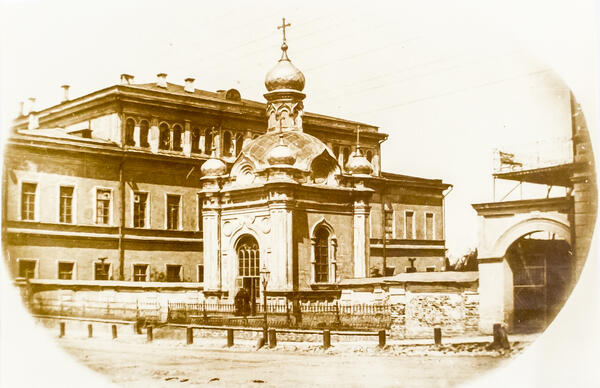The photograph of the early 20th century features a wonderful example of Kazan church architecture — a chapel in honor of the Martyr Alexandra of Rome. Legend has it that she was a Roman emperor’s wife during the persecution of Christians, and yet she was not afraid to speak openly of her faith.
Unfortunately, the chapel did not adorn Kazan for long: it was built in 1869, and demolished immediately after the Bolsheviks came to power, in 1917. Before the October Revolution, there were only five chapels in the city, and this was the largest.
According to information from Kazan deltiologists — collectors of postcards — there is only one photograph of the chapel, so the exhibit is valuable and rare.
The builders erected the chapel in 1868–1869. As the inscription on the wall said, it was erected “in memory of the deliverance of the Sovereign Emperor Alexander II from the villainous attempt on April 4, 1866”. It was on this day in St. Petersburg that Dmitry Karakozov, a member of an underground extremist organization, shot at the emperor. His attempt failed. The assassination attempt led to mass arrests, in addition, the government responded to the challenge by the conservative policy aimed at strengthening the autocracy, and abandoned many reforms. Karakozov was executed, and his associates received a life sentence.
At the same time, the supporters of the monarchy decided to commemorate the day when the emperor was saved. In Kazan, as well as in other cities of Russia, there began a campaign to raise money for the construction of chapels and other structures in memory of the event. In the Kazan governorate, the main part of the funds was collected by the nobility: therefore, in the end, the chapel was built on Gruzinskaya Street (today it is Karl Marx street) in the courtyard of the Noble Assembly. This location predetermined the sad fate of the building.
The fact is that Kazan Bolsheviks proclaimed Soviet power precisely in the premises of the Assembly of the Nobility, which was later called the House of the Peasant. It happened on October 26, 1917. Since Vladimir Lenin’s follows called religion “opium for the people”, they decided to demolish the chapel in the prominent place of the city center.
Unfortunately, the chapel did not adorn Kazan for long: it was built in 1869, and demolished immediately after the Bolsheviks came to power, in 1917. Before the October Revolution, there were only five chapels in the city, and this was the largest.
According to information from Kazan deltiologists — collectors of postcards — there is only one photograph of the chapel, so the exhibit is valuable and rare.
The builders erected the chapel in 1868–1869. As the inscription on the wall said, it was erected “in memory of the deliverance of the Sovereign Emperor Alexander II from the villainous attempt on April 4, 1866”. It was on this day in St. Petersburg that Dmitry Karakozov, a member of an underground extremist organization, shot at the emperor. His attempt failed. The assassination attempt led to mass arrests, in addition, the government responded to the challenge by the conservative policy aimed at strengthening the autocracy, and abandoned many reforms. Karakozov was executed, and his associates received a life sentence.
At the same time, the supporters of the monarchy decided to commemorate the day when the emperor was saved. In Kazan, as well as in other cities of Russia, there began a campaign to raise money for the construction of chapels and other structures in memory of the event. In the Kazan governorate, the main part of the funds was collected by the nobility: therefore, in the end, the chapel was built on Gruzinskaya Street (today it is Karl Marx street) in the courtyard of the Noble Assembly. This location predetermined the sad fate of the building.
The fact is that Kazan Bolsheviks proclaimed Soviet power precisely in the premises of the Assembly of the Nobility, which was later called the House of the Peasant. It happened on October 26, 1917. Since Vladimir Lenin’s follows called religion “opium for the people”, they decided to demolish the chapel in the prominent place of the city center.



